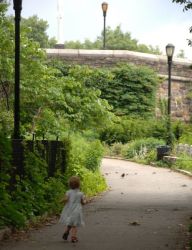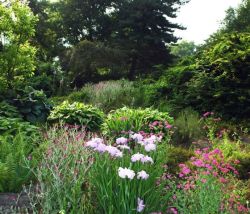Fort Tryon Park
Anne Loftus Playground
What was here before?
Early Dutch settlers referred to this forested, high ground as “Lang Bergh” or Long Hill. The Weckquaesgeek lived in the area until 1715, when they surrendered their last holdings in exchange for goods delivered by Colonel Stephen Van Cortlandt. The Continental Army fortified this site during the summer of 1776, but the troops were ousted a few months later by Hessian mercenaries. Subsequently, the battlements were renamed for Sir William Tryon, Major General and last British governor of colonial New York.
In the 19th century, wealthy New Yorkers began building elegant estates in the area. A later, notable arrival was Cornelius K.G. Billings, a wealthy horseman from Chicago. His lavish stone mansion, Tryon Hall, was completed in 1905. In 1917, John D. Rockefeller, Jr. purchased the 25-acre Billings estate, the largest estate in the Fort Tryon area. In 1927, after the Billings mansion was destroyed by fire, Rockefeller employed Olmsted Brothers to develop the property into a park. The land was deeded to the city by Rockefeller for a park in 1931.
How did this become a playground?
Between 1931 and 1935, Frederick Law Olmsted Jr. transformed rocky topography and thin soil into a stunning naturalistic and picturesque landscape. On this low-lying level north ground, and easily accessible location, Olmsted created a fan-shaped playground with rusticated retaining walls complete with open space for games, play equipment, a wading pool, and a field house. The park, including this Playground, opened on October 13, 1935.
Anne Loftus Playground was rebuilt in 1997. As it is the only playground designed by the firm of Olmsted Brothers, the renovation deliberately evoked the original footprint. Workers installed new pavement and safety surfacing, fencing, benches, trees, play equipment, a north arrow rosette, and picnic and game tables. A new spray shower was built on the site of the former wading pool, and an open performance space was added.
In 2022, the spray shower plaza was rebuilt, and the play equipment upgraded.
Who is this playground named for?
In 1990, the playground was named for Anne Susan Cahill Loftus (1925-1989). Born in Manhattanville, she was a beloved resident and leader of Inwood. Loftus served as district manager of Manhattan’s Community Board 12 from October 1980 until her death on September 28, 1989. During her tenure, she was a forceful advocate for the care and maintenance of local parks and playgrounds.
Check out your park's Vital Signs
Clean & Safe
Green & Resilient
Empowered & Engaged Users
Share your feedback or learn more about how this park is part of a
Vital Park System









